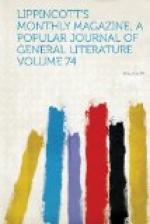For a century the friars labored in building their convent to accommodate the needs of their ever-increasing numbers: the one vast cloister was not enough, and another was added; the primitive chapel was enlarged into a stately church, and the abbey walls were extended until, enclosing the garden, they covered the entire promontory. Then they ceased from their labors, and began to establish other monasteries and send out swarms from the mother-hive to fill them, until the executive and administrative ability to govern a small kingdom had to be supplied from their numbers, and manual work had to give way to mental.
Another century found the abbey governed by men of culture and lovers of the fine arts; and the celebrated painted cloister, the intarsia-work, and the wooden sculptures, which now attract so many visitors, date from that time. Nearly all the movable works of art, the pictures, illuminated missals, and precious manuscripts, were confiscated at the time of the first suppression under Napoleon, in 1810; and whatever else could be carried off went in 1866, when the religious orders were suppressed by the Italian government, to embellish the museums. Still, the empty cloister, with Signorelli’s and Sodoma’s frescos on the walls, Fra Giovanni of Verona’s intarsia-work in the church, and the solitary monastery itself, so silent after centuries of activity, have an inexpressible charm, and travellers who undertake a pilgrimage hither can never forget their impressions.
On a sunny autumn afternoon three ladies left Siena in a light wagon, and drove over the gray upland, which was shrouded in a pale blue mist, through the picturesque hamlet of Buonconvento. Here they changed their horse and left the Roman highway for the road cut in the rocks five centuries ago by the monks of Monte Oliveto. These pious men understood little of engineering, of the art of throwing bridges across ravines. Their road simply followed the course pointed out by nature, winding in serpentine folds through the labyrinth of chasms which begin at Buonconvento.
It was toward evening when the party drove over a narrow bridge across a half-filled moat, and under the arch of a massive crenellated tower whose unguarded gates stood wide open. A hundred years ago they would have found the portcullis drawn, and, being women, if they had attempted to force an entrance would have been excommunicated, for until the suppression no woman’s foot was allowed across this threshold. The tower was built as a protection against bandits, and the grated windows which give it a sinister look to-day lighted the cells of refractory brothers, placed here to catch the eye of novices as they entered the outer portal and serve as a silent warning.
The convent was still invisible, and our three visitors were speculating on what they would find at the end of the grass-grown allee bordered with cypresses, when they saw, in a ravine below, a white-robed figure hastening toward them.




